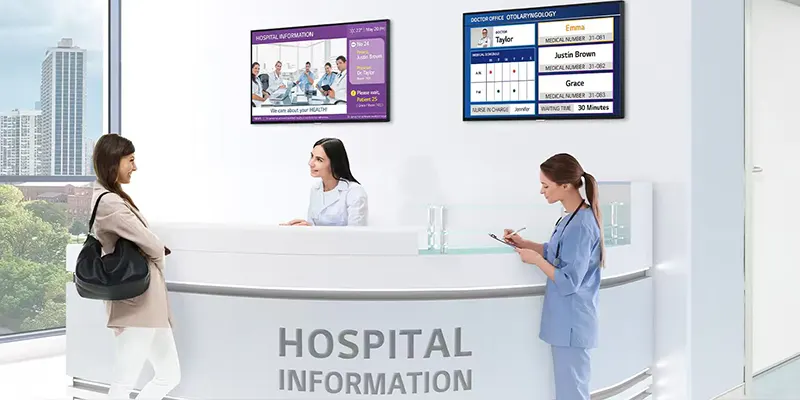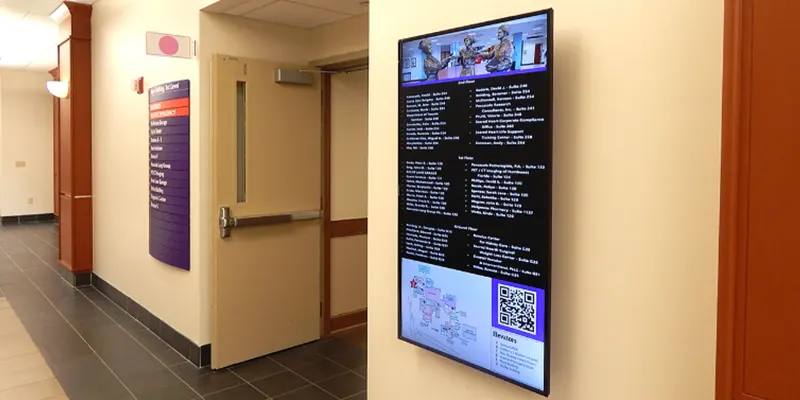What Is Digital Signage for Hospitals?
In today’s fast-paced healthcare environment, digital signage for hospitals has become a game-changer in how medical institutions communicate. It refers to the use of digital screens—such as LED displays, video walls, and interactive kiosks—to share real-time information, announcements, and health education with patients, visitors, and staff.
Unlike traditional static boards or printed posters, digital signage enables dynamic, visually appealing, and instantly updatable communication. Hospitals use it to display everything from appointment schedules and wayfinding directions to emergency alerts and public health messages.
Ultimately, digital signage helps hospitals achieve a smoother flow of information, improves patient satisfaction, and enhances operational efficiency.
1. How Digital Signage Works in Hospitals
Digital signage systems operate through a network of connected screens managed by a central content management system (CMS). This allows administrators to upload, schedule, and modify content across multiple displays in real time.
A typical setup includes:
Display screens: Placed in lobbies, corridors, waiting rooms, and cafeterias.
Media players: Devices that process and transmit visual content to each screen.
Content Management System (CMS): Software that allows centralized control and customization.
Network connection: Ensures seamless updates and synchronization across all screens.
This technology provides flexibility—staff can instantly share emergency alerts, display welcome messages, or broadcast health awareness campaigns without physical replacements or delays.

2. Benefits of Digital Signage in Healthcare Facilities
The advantages of digital signage in hospitals are far-reaching, impacting both patient experience and staff efficiency.
Key Benefits Include:
1.Improved Patient Experience: Patients stay informed with real-time updates, estimated wait times, and educational videos that ease anxiety.
2.Enhanced Internal Communication: Hospital staff receive instant notifications, shift changes, and safety reminders through internal displays.
3.Better Wayfinding: Interactive maps and digital directories help visitors find departments quickly, reducing confusion.
4.Health Awareness: Hospitals can promote wellness campaigns, vaccination drives, or health check-up reminders.
5.Operational Efficiency: Staff spend less time manually updating boards or distributing flyers.
In short, digital signage acts as a communication bridge—delivering the right message to the right audience at the right time.
3. Practical Applications of Digital Signage in Hospitals
Digital signage can be used in various ways to improve both front-end and back-end operations within a healthcare facility.
Common Applications Include:
1.Reception and Waiting Areas: Display appointment queues, waiting times, and educational content.
2.Emergency Rooms: Communicate triage priorities, safety alerts, and emergency protocols.
3.Staff Break Rooms: Share internal news, shift schedules, and training updates.
4.Cafeterias and Public Spaces: Promote hospital events, menus, or health awareness campaigns.
5.Patient Rooms: Provide personalized messages, discharge instructions, and entertainment options.
Each application serves a unique purpose but contributes to the broader goal—creating an informed and connected hospital environment.
4. Implementing an Effective Digital Signage Strategy
To successfully deploy digital signage, hospitals should follow a clear strategy that combines content planning, technical setup, and user engagement.
Key Implementation Steps:
Define Objectives: Determine whether the goal is patient engagement, staff communication, or public awareness.
Select the Right Hardware: Invest in high-quality displays suited to hospital lighting and environmental conditions.
Use a Reliable CMS: Ensure the system allows easy content updates, scheduling, and user permissions.
Create Engaging Content: Use visuals, infographics, and videos to make messages more memorable.
Consider Accessibility: Include multilingual support, subtitles, and large fonts for better readability.
Monitor Performance: Regularly evaluate engagement metrics and adjust the strategy based on results.
When executed properly, digital signage not only informs but also enhances the overall patient journey—from arrival to discharge.
Conclusion: Digital Signage—A Vital Tool for Modern Hospitals
Digital signage is no longer a luxury—it’s a necessity for modern healthcare institutions striving to improve communication and patient satisfaction. From guiding visitors to sharing vital updates, it makes every interaction within a hospital more seamless and engaging.
Hospitals that adopt digital signage enjoy faster information delivery, stronger branding, and improved patient trust. Whether it’s a small clinic or a large medical center, this technology helps bridge communication gaps and foster a better healthcare experience for everyone.
If you’re interested in implementing a digital signage system in your hospital or want to learn more about its benefits, feel free to contact our team anytime for expert guidance and customized solutions.

FAQs
1. What is digital signage in hospitals?
Digital signage in hospitals refers to the use of electronic displays to share information, directions, announcements, and health education with patients, visitors, and staff.
2. How does digital signage improve patient experience?
It provides real-time updates, reduces confusion, and displays calming or informative content, helping patients feel more informed and comfortable.
3. Is digital signage expensive to maintain?
While there is an initial investment, maintenance is minimal and cost-effective compared to traditional printing and manual updates.
4. Can digital signage integrate with hospital management systems?
Yes, advanced systems can connect with HMS or EMR platforms for automatic content updates like appointment statuses or room changes.
5. What are the best places to install digital signage in hospitals?
Common locations include entrances, waiting areas, corridors, cafeterias, and staff rooms for maximum visibility and engagement.
